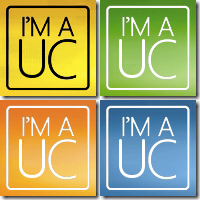Communications Server 14, First Look
Today I attended (all be it virtually) a Live Meeting arranged by Russ Kirk, a fellow MVP for Communications Server and Microsoft UC User Group facilitator. The presentation, named “Communications Server 14, First Look” was hosted by the Microsoft UK UC product team and split into two sections:
- Client features (Communicator 14)
- Server features (Communications Server 14)
As many of you may well be aware VoiceCon (Orlando 22nd-24th March) was used as a vehicle to announce a number of new features within the next iteration of OCS (now Communications Server). In case you missed this, Gurdeep Singh Pall’s keynote it available as a streaming video via the VoiceCon website (registration required).
Today’s presentation went into a “little” more detail and gave the community an opportunity to ask questions (some of these Q&As are included below)
First off, Client features, within Communicator 14
- Skill search, this essentially interrogates pre-populated information contained within SharePoint 2007 (and of course the forthcoming release SharePoint 2010) – this information comprises of skills, projects and interests.
- Contact card, this has been given a UI refresh and location information is made available (unlike previously, the contact card can be “pinned” to desktop) – presumably much like gadgets within Windows 7.
- Voicemail, this can now be played directly within Communicator for those too lazy to hunt down the option within Outlook. If you are using Exchange 2010 you’ll get the transcript too, Exchange 2007 users will have to cope with audio only.
- Location, location, location. Yes as previously mentioned at VoiceCon, location information is now set automatically. This is handled by a “location information server” or LIS. Wikipedia’s defines this as,
“The LIS is a service that is provided by an access network provider to provide location information to users of the network. To do this, it uses knowledge of network topology and a range of location determination techniques to locate devices that are attached to the network. The precise methods that are used to determine location are dependent on the type of access network and the information that can be obtained from the device.”
This location information can of course be suppressed using group policy or set granularly by the user, utilising the built-in Communicator permission controls. It should also be noted that this geographic information is sent when an emergency call (e-911) is made to help the operator establish the caller’s whereabouts. This is a commonly known requirement for VoIP only PBX solutions used within North America and seeing as CS14 is being pitched as a “PBX killer” you probably get why this is included!
Next, Server features, within Communications Server “14”
- The story so far…OCS 2007, delivered the vast majority of “critical voice functionality”, Microsoft estimates 71%, R2 then addresses an additional 17%. CS14 will complete this by offering the remaining 12%. This includes,
- e-911 for N. America (as mentioned above)
- “Survivable Branch Appliances” or SBA for high-availability telephony
- Call Admission Control or CAC (a way of limiting VoIP over utilisation on your respective LAN/WAN)
- Additional “optimised for OCS” hardware at better/cheaper prices
- Call parking
- Malicious call traces
- Additional data centre survivability options (more on this at Tech-Ed North America).
- Disclosure of VoiceCon RFP, Microsoft claimed that approximately a 20% reduction in total system costs could be leveraged when put against a like-for-like investment from alternate vendors (the vast majority on end-user hardware)
- Call Admission Control
- Fully configurable based on location, topology, links and limits for voice/video
- If session exceeds a threshold it can take pre-defined alternate routes i.e. PSTN or Internet
- E-911
- Location can be obtained by 3rd party SIP trunk provider
- P-ANIs not required
- Integrated LIS Server
- Locations can be based on subnet, switch, port or WiFi access point
- Complete mobility support for both soft and hard phones
- Branch Availability
- SBA from multiple vendors
- Both gateway and software in an appliance (previously I blogged about a 2007 R2 version from StartReady)
- Automatic failover and failback (if WAN fails then use PSTN)
- Standalone mediation server a thing of the past.
- All roles can be consolidated except monitoring.
- Lots of monitoring (both hardware and software)
- Remote call control is supported for existing deployments (i.e. customers upgrading from 2007 RCC to 14)
- Dual forking is no longer supported by Microsoft. (This is the process whereby a user might utilise both OCS optimised device and a PBX phone) Initially this requirement was set by telephony vendors, however in many cases it was not brought to market successfully or adopted at all. I however have seen this setup work extremely well with the Nortel CS1000, it should still work, however if you experience any issues you are sadly on your own. During the presentation it was mentioned that by setting up “simultaneously ring another number” within Communicator it would provide a sufficient workaround for this.
- Increased operability for PBX vendors to integrate with CS14 presence, providing end-user telephony states is obviously a sweet spot for Communicator adoption.
Q&A
- A new version of Communicator will be released for the Mac platform
- CS14 is currently slated for a Q4 calendar year release
- A personal bug-bear of mine (and MS apparently) is addressed, the scenario – when you attach a USB phone/headset post Communicator load and the new sound device is not detected unless you close and re-open the client. A new button automatically re-detects newly connected devices, therefore addressing the problem – hurrah!
Expect more information to be released early June during Tech-Ed North America.





I’m curious about the location information server. What does this mean to end users like me? Will everyone on OCS see “where” I am? Can I set my location to be “in cube” or “at home” or “on travel”?
Hi Karen,
The amount of location information you desire to share is up to you and yes it can be overridden manually.
– Adam